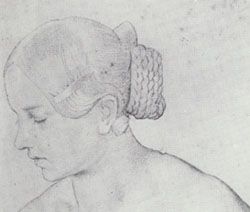
Mr. Klein is an independent art historian known for his various discoveries of lost art. Klein's finding of a drawing by Schnorr, "Half-Nude Female," in the collection of the State Art Museum in Mannheim, Germany, put his investigative process in motion. Klein claims that the Mannheim drawing depicts the identical young woman with related braided hair as the "Principessa."
 Among those who also reject that the "Principessa" is da Vinci's are Carmen Bambach of the Metropolitan Museum and Martin Clayton. Clayton is the curator of the Royal Collection at Windsor Castle, which has the world's largest collection of drawings da Vinci drawings. Bambach is the leading expert on Leonardo's drawings.
Among those who also reject that the "Principessa" is da Vinci's are Carmen Bambach of the Metropolitan Museum and Martin Clayton. Clayton is the curator of the Royal Collection at Windsor Castle, which has the world's largest collection of drawings da Vinci drawings. Bambach is the leading expert on Leonardo's drawings. Julius Schnoor von Carolsfeld, who lived from 1794-1872, is one of the relatively unknown Nazarene Brotherhood of German painters who worked in Rome and copied the styles and subjects of Italian Renaissance masters.
Klein previously has uncovered four unsigned drawings and one painting by other Nazarene artists in his investigative endeavors. Those drawings and collections are displayed in museum collections that include New York's Morgan Library and the Frances Lehman Loeb Museum at Vassar College.
"The Mannheim drawing depicts the identical young woman with related braided hair as the "Principessa," and it's drawn on the identical vellum as well. Vellum, or parchment, is an eccentric material for drawing, which Schnorr often used, and Leonardo never used. Two other Schnorr drawings on vellum are at Mannheim. The "Principessa" recreates the exact woman, idealized in the manner of a Renaissance engagement portrait - possibly a gift from Schnorr to a favorite model. The real question has always been "who really done it?" Well, here's the smoking gun, and Leonardo is not holding it."
Martin Kemp, the principal author of the recently released "La Bella Principessa: The Story of the New Masterpiece by Leonardo da Vinci," presents supportive forensic evidence along with his opinion that the painting is by da Vinci.
"Questionable connoisseurship all around," said Klein. "I have no vested interest here other than the pursuit of truth in art history and a longstanding desire to keep Leonardo's and other old masters' work free of fakes, bogus science, and substandard connoisseurship by people in positions of authority. In the case of "La Principessa," let's just say it's clearly an issue of mistaken identity."
Apparently, in this case, it is simpler to know what you like than it is to determine which should be attributable to whom.
www.ereleases.com









